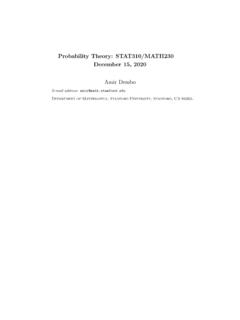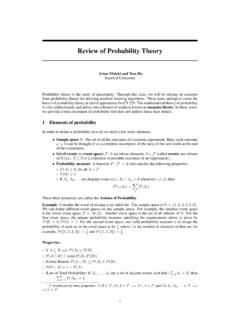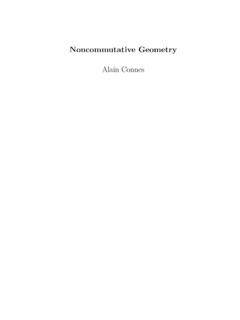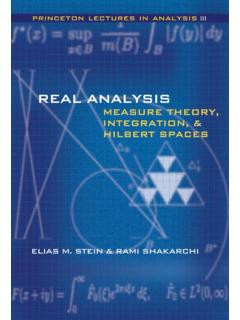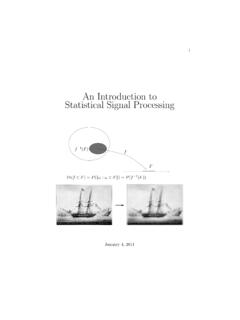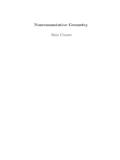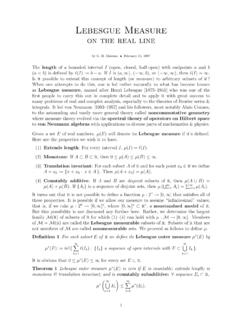Search results with tag "Measure theory"
Probability Theory: STAT310/MATH230 April15,2021
statweb.stanford.eduIn measure theory we sometimes consider signed measures, whereby µis no longer non-negative, hence its range is [−∞,∞], and say that such measure is finite when its range is R(i.e. no set in F is assigned an infinite measure). Definition 1.1.3. A measure space is a triplet (Ω,F,µ), with µa measure on the measurable space (Ω,F).
Review of Probability Theory - Stanford University
cs229.stanford.edubasics of probability theory at a level appropriate for CS 229. The mathematical theory of probability is very sophisticated, and delves into a branch of analysis known as measure theory. In these notes, we provide a basic treatment of probability that does not address these finer details. 1 Elements of probability
LECTURE NOTES IN MEASURE THEORY - Chalmers
www.math.chalmers.se1 LECTURE NOTES IN MEASURE THEORY Christer Borell Matematik Chalmers och Göteborgs universitet 412 96 Göteborg (Version: January 12)
Noncommutative Geometry Alain Connes
alainconnes.orgcorrespondence to the noncommutative case in the framework of real analysis. The theory, called noncommutative geometry, rests on two essential points: 1. The existence of many natural spaces for which the classical set-theoretic tools of analysis, such as measure theory, topology, calculus, and metric ideas lose their
REAL ANALYSIS - Centro de Matemática
www.cmat.edu.uyII. Complex analysis. III. Measure theory, Lebesgue integration, and Hilbert spaces. IV. A selection of further topics, including functional analysis, distri-butions, and elements of probability theory. However, this listing does not by itself give a complete picture of the many interconnections that are presented, nor of the applications
Stochastic Processes - Stanford University
statweb.stanford.eduThis chapter is devoted to the mathematical foundations of probability theory. Section 1.1 introduces the basic measure theory framework, namely, the proba-bility space and the σ-fields of events in it. The next building block are random variables, introduced in Section 1.2 as measurable …
AnIntroductionto StatisticalSignalProcessing
ee.stanford.edu2.3 Probability spaces 22 2.4 Discrete probability spaces 44 2.5 Continuous probability spaces 54 2.6 Independence 68 ... with measurable results. ... measure theory. A primary goal of this approach is thus to use intuitive arguments
Noncommutative Geometry Alain Connes
www.alainconnes.org1. MEASURE THEORY (CHAPTERS I AND V) 8 Let us now discuss in more detail the extension of the classical tools of analysis to the noncommutative case.
Measure Measure - Department of Mathematics
math.unl.eduto the astounding and vastly more general theory called noncommutative geometry where measure theory evolved via the spectral theory of operators on Hilbert space to von Neumann algebras with applications to diverse parts of mathematics & physics. Given a set E of real numbers, µ(E) will denote its Lebesgue measure if it’s defined.
Theory of functions of a real variable.
people.math.harvard.eduThe course itself consists of two parts: 1) measure theory and integration, and 2) Hilbert space theory, especially the spectral theorem and its applications. In Chapter II I do the basics of Hilbert space theory, i.e. what I can do without measure theory or …
Measure Notes - University of California, Davis
www.math.ucdavis.edutions of rectangles, not just finite collections, to define the outer measure.2 The ‘countableǫ-trick’ used in the example appearsin variousforms throughout measure theory. Next, we prove that µ∗ is an outer measure in the sense of Definition 1.2. Theorem 2.4. Lebesgue outer measure µ∗ has the following properties. (a) µ∗(∅) = 0;
Measure Theory JohnK.Hunter
www.math.ucdavis.eduDefinition 1.5. A measurable space (X,A) is a non-empty set Xequipped with a σ-algebra A on X. It is useful to compare the definition of a σ-algebra with that of a topology in Definition 1.1. There are two significant differences. First, the complement of a measurable set is measurable, but the complement of an open set is not, in general,
